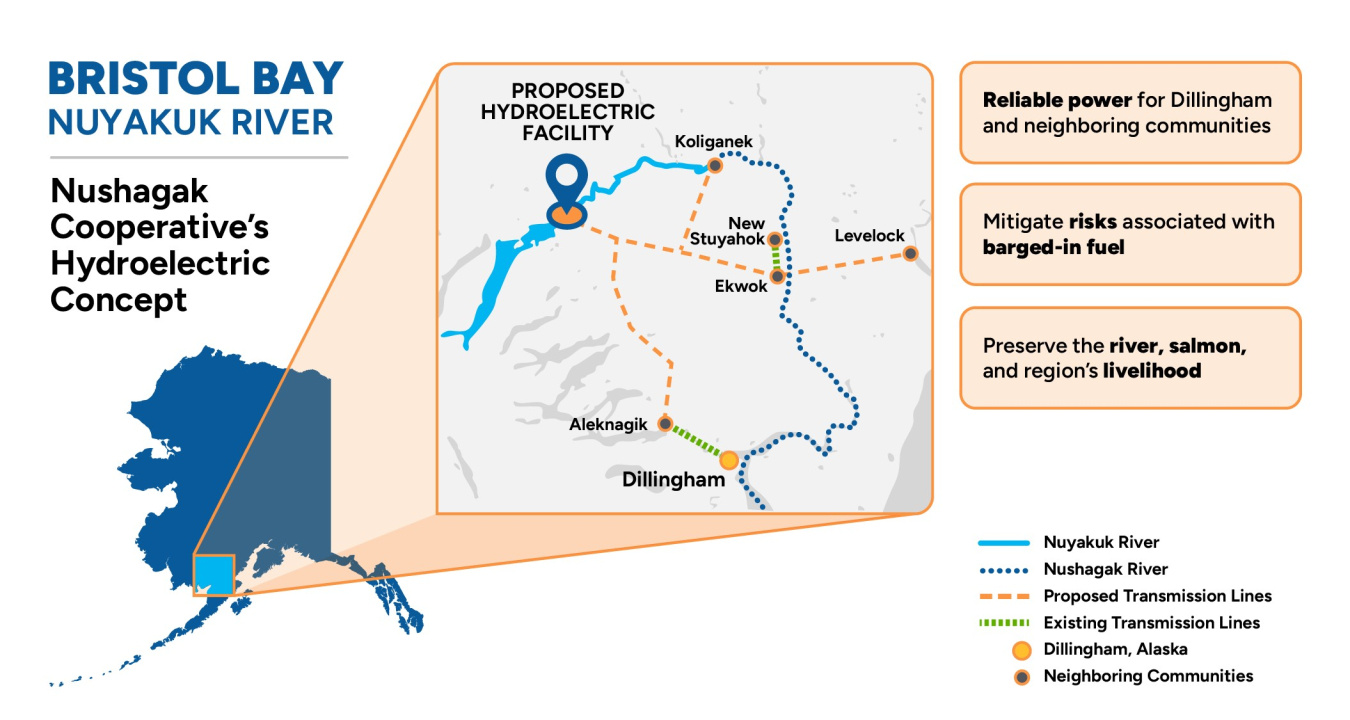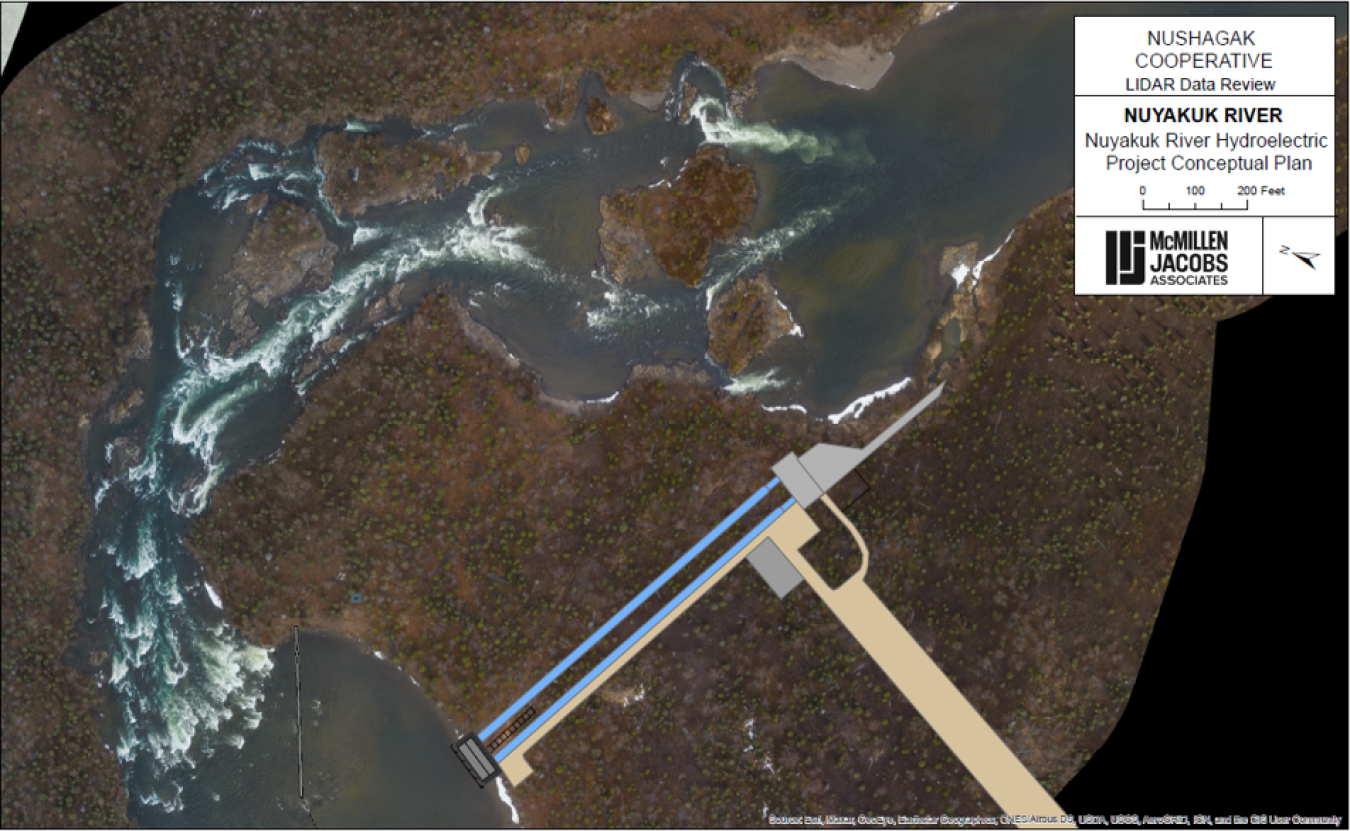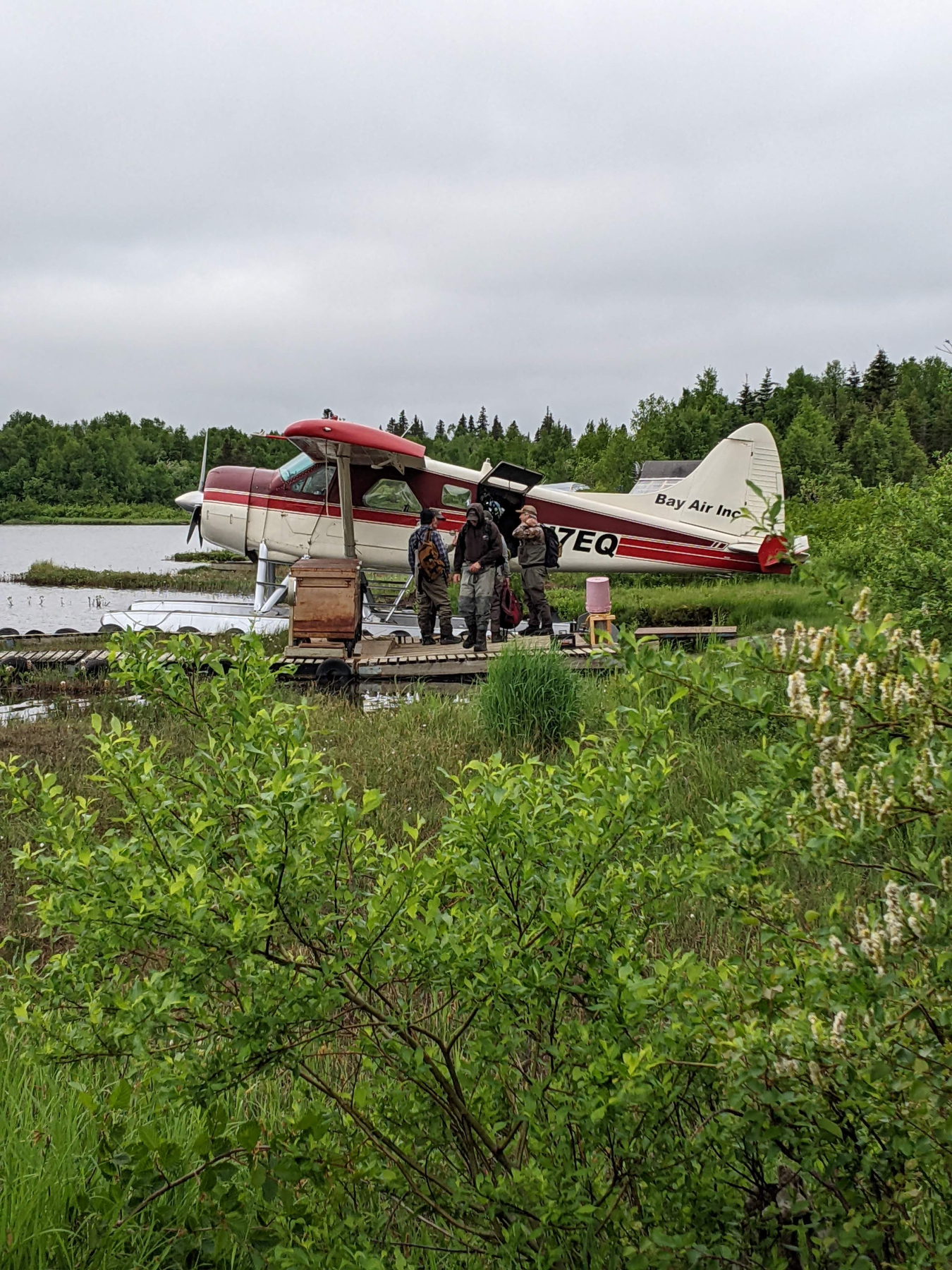With technical assistance from the U.S. Department of Energy’s Energy Technology Innovation Partnership Project, the town of Dillingham, Alaska is considering a hydropower project to help the community reach its energy resilience and environmental goals.
Water Power Technologies Office
January 17, 2023Dillingham, Alaska, and its 2,250 residents reside on the banks of Nushagak Bay at the mouth of the Nushagak River. The town is not connected to Alaska’s statewide road system and the only way to reach Dillingham is by boat or plane. Its isolated location on an arm of the Bering Sea means that everyday necessities, such as fuel, food, and other supplies, aren’t easy to access. This remote inlet of Bristol Bay is also home to the world’s largest run of sockeye salmon, making a reliable and resilient energy system critical to meeting the ever-growing global demand for wild Alaskan salmon.
Listen to the recording:

This graphic describes the benefits of the proposed hydroelectric facility and shows Dillingham’s location in relation to the proposed facility, as well as where Dillingham is located within the state of Alaska.
Dillingham’s local utility, Nushagak Electric and Telephone Cooperative (NETC), has put affordable and reliable energy at the center of its community’s resilience goals. Diesel fuel currently powers the town, but with costly fuel prices and potential roadblocks in reliably importing fuel, locally generated energy is a priority for the member-owned and -operated cooperative that provides Dillingham’s electric, telephone, cable television, and internet services.
To help Dillingham reach its energy goals, NETC applied for the U.S. Department of Energy's Energy Technology Innovation Partnership Project (ETIPP) in 2021 and was selected to receive technical assistance in evaluating the environmental and economic impacts of a potential run-of-river hydroelectric project.
“We’ve participated in wind energy studies, looked at other options, like natural gas conversion and solar, which are great for supplementing other sources of renewable energy,” said Bob Himschoot, NETC's recently retired CEO and general manager. “But data shows that hydropower is the golden ticket for Dillingham. This project has the potential to replace up to 1.5 million gallons of diesel fuel annually while providing a surplus of power to Dillingham and nearby villages year round.”
After reviewing more than 60 years of U.S. Geological Survey stream flow data, NETC identified a location on the Nuyakuk River that hosts ideal conditions for a low-impact, run-of-river hydropower project. The site is located about 60 miles northeast of Dillingham within the boundaries of Wood-Tikchik State Park.
The site’s geological characteristics make it special. Located on a bend in the river, the chosen spot is perfect for minimally diverting the river’s flow; in other words, this hydropower facility wouldn’t involve a dam. Instead, the potential hydropower project would use a diversion feature upstream of the bend to redirect some of the river’s flow. The water would pass through about a quarter mile of pipes and into a powerhouse where the electricity would be generated—all of which would be on land. Once the water passes through the powerhouse, it would then return to the river downstream of the bend.

This aerial image shows the site location for a potential hydroelectric project on the Nuyakuk River near Dillingham, Alaska. Some water would be diverted upstream of the bend, run through land-based pipes, and be reintroduced to the natural river downstream of the bend
Rapid waterfalls are also key to this location—a 28-foot drop in elevation occurs rapidly through a series of falls situated on a half-mile stretch in the river. Together, the elevation drop and waterfalls make the site nearly unbeatable for a low-impact, run-of-river project. The change in elevation allows water to travel downhill, enabling the facility to generate more power—providing a plentiful source of year-round power to Dillingham and five neighboring towns (Koliganek, Stuyahok, Ekwok, Levelock, and Aleknagik). And because the water is so turbulent in this area, salmon and other fish are unlikely to spawn there, meaning the impact on fish populations, and the ecosystem in general, would be minimal.
“We're in this Catch-22 where we want to protect and preserve the environment while also moving the salmon industry forward, knowing that it's going to require more energy,” said Will Chaney, NETC’s current CEO and general manager. “Currently, more energy means more diesel, which is costly for our cooperative members and for the environment. So, we want to rely on less impactful, alternative energy sources while also preserving the salmon and our home.”
Dillingham Taps Into Technical Assistance

Rapid waterfalls rush down a half-mile stretch of the Nuyakuk River, the site location near Dillingham, Alaska, for a potential hydroelectric project.
ETIPP has connected NETC with experts—from economists to hydrologists to regional partners at the Renewable Energy Alaska Project—who can help Dillingham reach its energy resilience and environmental goals. Since 2021, researchers at the Pacific Northwest National Laboratory (PNNL) and Sandia National Laboratories (Sandia) have been working with NETC to develop an economic decision-making support tool that allows the cooperative to understand and assess the potential economic impacts of this hydropower project.
Mark Weimar, an economist at PNNL, created the spreadsheet-based tool and tailored it to meet Dillingham’s unique needs. It allows users to explore how different assumptions, including stream flow and water diversion limits, may interact with each other. For example, the user can assess how the hydropower project might offset residential and commercial diesel fuel consumption in different scenarios by inputting a specific climate condition, the quantity of fish, or the level of energy demand.
“From my standpoint, it’s really nice to be a part of something that has instant purpose,” said Weimar. “Research projects normally take effect maybe 10 to 30 years down the line. This decision-making tool allows us to see immediate results that include many nuanced factors. Not only will the tool help Dillingham decide whether to move forward with the hydropower project, but it will also help NETC make operational decisions down the line if the project does move forward.”
To help users arrange inputs and read outputs in the intricate spreadsheet, the team created a slide deck, which acts as a tutorial for those using the tool.
To make the tool more inclusive and accessible, the ETIPP technical assistance team is also developing a front-end graphical user interface (GUI) that makes it easier for users to explore different scenarios. The GUI is intended to enable anyone in the community to play with different assumptions using a simpler version of the spreadsheet.
“This work is really a community-driven effort,” said Thushara Gunda, a hydrologist at Sandia. “As a cooperative, NETC is really mindful of its stakeholders’ needs and actively includes the entire community in technical conversations, project milestones, and future plans. It’s been incredibly inspiring to be part of that.”
Just Around the River Bend: What’s Next for NETC and Dillingham

NETC and members of the ETIPP technical assistance team arrive at the isolated Alaskan site location for a potential hydroelectric project.
Dillingham’s ETIPP technical assistance project concluded in December 2022, after which NETC will spend two years studying various economic and environmental impacts of the proposed run-of-river facility (as part of the federal process for evaluating potential hydropower projects).
NETC can then input the results of those studies into the decision-making tool and more thoroughly evaluate the impacts of various scenarios. If the results show the project would positively affect the region by strengthening its energy resiliency and overall self-sufficiency (while avoiding any impact to the subsistence fishing community), then NETC will take the first steps to begin construction—keeping Dillingham’s regional stakeholders involved throughout.
Given the isolated terrain and licensing logistics, a finished facility could take up to eight to 10 years, but once it’s complete, the hydropower project would provide reliable power to Dillingham and even more remote communities that rely on NETC.
The energy generated by the hydropower facility could also support more onshore fish processing. Preparing and packaging caught fish for consumers is very energy-intensive and has contributed to the region’s new and growing energy demands, requiring local utility companies to double their power production during the two-month processing season. If Dillingham can build and power local processing plants using energy from the river, then fish processing could lower economic and environmental costs. More Dillingham-based facilities could provide more jobs for the region’s residents—while also giving the community greater independence and presence in the salmon market.
This hydropower project could also help Dillingham establish a stronger connection to the rest of the world. In building the transmission lines (which will carry the electricity from the hydropower facility to the various nearby communities), NETC also plans to install fiber-optic cable to improve access to high-speed internet. Increased broadband access can help support communications needs and provide opportunities for the communities to grow both socially and economically for generations to come.
“ETIPP is the kind of program that encourages communities like Dillingham to take advantage of new opportunities that set them up for success,” said Rob Jordan, an Alaska-based microgrid coordinator at Renewable Energy Alaska Project. “Most importantly, NETC and the ETIPP technical assistance team’s goals fit into a greater continuum of work that is going on in the Dillingham community, and it's all moving toward sustainability and reliability of the community’s existing values and assets.”
Several technology offices within the U.S. Department of Energy’s Office of Critical Materials and Energy Innovation support ETIPP, including the Water Power Technologies Office. The National Laboratory of the Rockies manages ETIPP to identify and plan strategic energy solutions that address a community's specific challenges. Learn more about ETIPP and the other communities that aim to achieve local resiliency goals through reliable and affordable energy.

